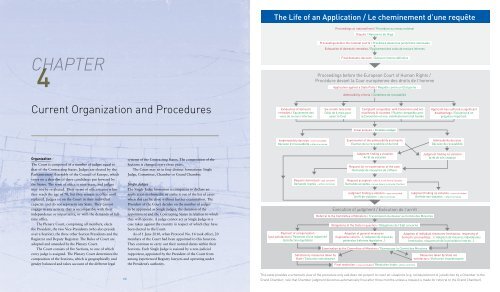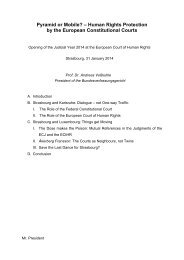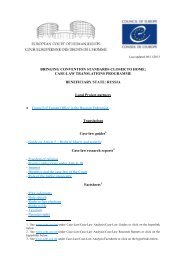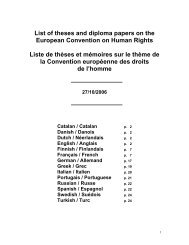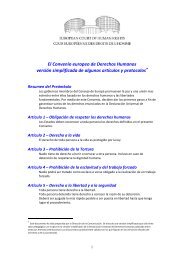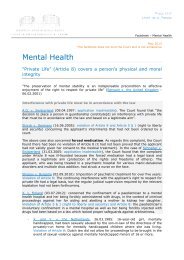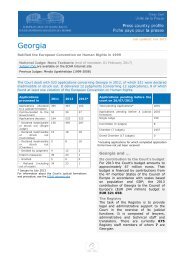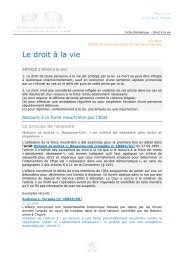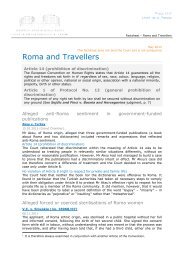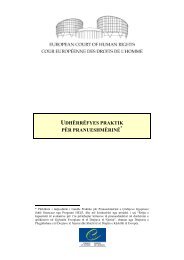The Conscience of Europe - European Court of Human Rights ...
The Conscience of Europe - European Court of Human Rights ...
The Conscience of Europe - European Court of Human Rights ...
Create successful ePaper yourself
Turn your PDF publications into a flip-book with our unique Google optimized e-Paper software.
chapter<br />
4<br />
Current Organization and Procedures<br />
Organization<br />
<strong>The</strong> <strong>Court</strong> is composed <strong>of</strong> a number <strong>of</strong> judges equal to<br />
that <strong>of</strong> the Contracting States. Judges are elected by the<br />
Parliamentary Assembly <strong>of</strong> the Council <strong>of</strong> <strong>Europe</strong>, which<br />
votes on a shortlist <strong>of</strong> three candidates put forward by<br />
the States. <strong>The</strong> term <strong>of</strong> <strong>of</strong>fice is nine years, and judges<br />
may not be re-elected. <strong>The</strong>ir terms <strong>of</strong> <strong>of</strong>fice expire when<br />
they reach the age <strong>of</strong> 70, but they remain in <strong>of</strong>fice until<br />
replaced. Judges sit on the <strong>Court</strong> in their individual<br />
capacity and do not represent any State. <strong>The</strong>y cannot<br />
engage in any activity that is incompatible with their<br />
independence or impartiality, or with the demands <strong>of</strong> fulltime<br />
<strong>of</strong>fice.<br />
<strong>The</strong> Plenary <strong>Court</strong>, comprising all members, elects<br />
the President, the two Vice-Presidents (who also preside<br />
over a Section), the three other Section Presidents and the<br />
Registrar and Deputy Registrar. <strong>The</strong> Rules <strong>of</strong> <strong>Court</strong> are<br />
adopted and amended by the Plenary <strong>Court</strong>.<br />
<strong>The</strong> <strong>Court</strong> consists <strong>of</strong> five Sections, to one <strong>of</strong> which<br />
every judge is assigned. <strong>The</strong> Plenary <strong>Court</strong> determines the<br />
composition <strong>of</strong> the Sections, which is geographically and<br />
gender balanced and takes account <strong>of</strong> the different legal<br />
66<br />
systems <strong>of</strong> the Contracting States. <strong>The</strong> composition <strong>of</strong> the<br />
Sections is changed every three years.<br />
<strong>The</strong> <strong>Court</strong> may sit in four distinct formations: Single<br />
Judge, Committee, Chamber or Grand Chamber.<br />
Single Judges<br />
<strong>The</strong> Single-Judge formation is competent to declare an<br />
application inadmissible or strike it out <strong>of</strong> the list <strong>of</strong> cases<br />
when this can be done without further examination. <strong>The</strong><br />
President <strong>of</strong> the <strong>Court</strong> decides on the number <strong>of</strong> judges<br />
to be appointed as Single Judges, the duration <strong>of</strong> the<br />
appointment and the Contracting States in relation to which<br />
they will operate. A judge cannot act as Single Judge in a<br />
case taken against the country in respect <strong>of</strong> which they have<br />
been elected to the <strong>Court</strong>.<br />
As <strong>of</strong> 1 June 2010, when Protocol No. 14 took effect, 20<br />
members <strong>of</strong> the <strong>Court</strong> had been appointed to this function.<br />
<strong>The</strong>y continue to carry out their normal duties within their<br />
Sections. Each Single Judge is assisted by a non-judicial<br />
rapporteur, appointed by the President <strong>of</strong> the <strong>Court</strong> from<br />
among experienced Registry lawyers and operating under<br />
the President’s authority.<br />
<strong>The</strong> Life <strong>of</strong> an Application / Le cheminement d’une requête<br />
Exhaustion <strong>of</strong> domestic<br />
remedies / Epuisement des<br />
voies de recours internes<br />
Inadmissibility decision = case concluded<br />
Décision d’irrecevabilité = affaire terminée<br />
Request dismissed = case conluded<br />
Demande rejetée = affaire terminée<br />
Payment <strong>of</strong> compensation<br />
(just satisfaction) / Paiement d’une indemnité<br />
(satisfaction équitable)<br />
Proceedings at national level / Procédure au niveau national<br />
Proceedings before the <strong>Europe</strong>an <strong>Court</strong> <strong>of</strong> <strong>Human</strong> <strong>Rights</strong> /<br />
Procédure devant la Cour européenne des droits de l’homme<br />
Satisfactory measures taken by<br />
State / Exécution satisfaisante<br />
Exhaustion <strong>of</strong> domestic remedies / Epuisement des voies de recours internes<br />
Application against a State Party / Requête contre un Etat partie<br />
Six-month time limit<br />
Délai de 6 mois pour<br />
saisir la Cour<br />
Dispute / Naissance du litige<br />
Proceedings before the national courts / Procédure devant les juridictions nationales<br />
Final domestic decision / Décision interne définitive<br />
Admissibility criteria / Conditions de recevabilité<br />
Complaint compatible with Convention and not<br />
manifestly ill-founded / Plainte compatible avec<br />
la Convention et non manifestement mal fondée<br />
Initial analysis / Première analyse<br />
Examination <strong>of</strong> the admissibility and merits<br />
Examen de la recevabilité et du fond<br />
Judgment finding a violation<br />
Arrêt de violation<br />
Request for re-examination <strong>of</strong> the case<br />
Demande de réexamen de l’affaire<br />
Request accepted = referral to the Grand Chamber<br />
Demande acceptée = renvoi devant la Grande Chambre<br />
Judgment finding a violation = case concluded<br />
Arrêt de violation = affaire terminée<br />
Execution <strong>of</strong> judgment / Exécution de l’arrêt<br />
Referral to the Committee <strong>of</strong> Ministers / Transmission du dossier au Comité des Ministres<br />
Obligations <strong>of</strong> the State in question / Obligations de l’Etat concerné<br />
Adoption <strong>of</strong> general measures<br />
(legislative reform...) / Adoption de mesures<br />
générales (réforme législative...)<br />
Examination by the Committee <strong>of</strong> Ministers / Examen par le Comité des Ministres<br />
Final resolution = case concluded / Résolution finale = affaire terminée<br />
Applicant has suffered a significant<br />
disadvantage / Existence d’un<br />
préjudice important<br />
Admissibility decision<br />
Décision de recevabilité<br />
Judgment finding no violation<br />
Arrêt de non-violation<br />
Judgment finding no violation = case concluded<br />
Arrêt de non-violation = affaire terminée<br />
Adoption <strong>of</strong> individual measures (restitution, reopening <strong>of</strong><br />
domestic proceedings...) / Adoption de mesures individuelles<br />
(restitution, réouverture de la procédure interne...)<br />
Measures taken by State not<br />
satisfactory / Exécution insatisfaisante<br />
This table provides a schematic view <strong>of</strong> the procedure only and does not purport to cover all situations (e.g. relinquishment <strong>of</strong> jurisdiction by a Chamber to the<br />
Grand Chamber; rule that Chamber judgment becomes automatically final after three months unless a request is made for referral to the Grand Chamber).


